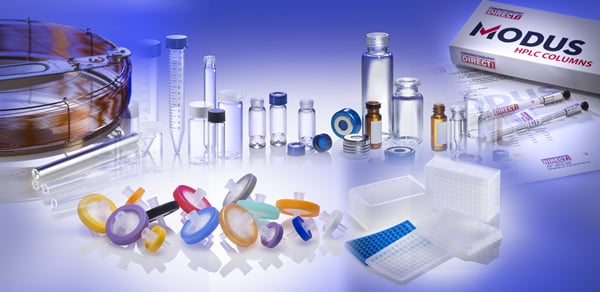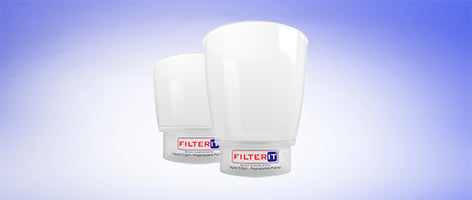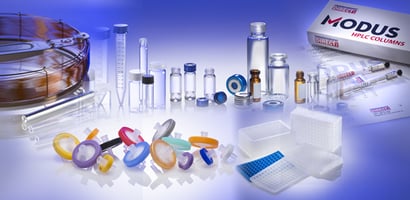Today, we want to shed light on the crucial role that chromatography consumables play in analytical...
Demystifying Chromatography Consumables: A Comprehensive Guide
Introduction
Chromatography consumables are essential components in analytical workflows, enabling scientists to precisely separate, identify, and quantify compounds. In this blog post, we will explore the various types of chromatography consumables, shedding light on their unique functions, applications, and importance in scientific research and industry. But first, let's delve into the world of chromatography consumables and understand their significance in achieving reliable analytical results.

HPLC Columns
High-Performance Liquid Chromatography (HPLC) columns are at the heart of chromatographic separations. These columns consist of a stationary phase and a mobile phase that facilitate the separation of complex mixtures. In addition, different column chemistries, such as reverse phase, normal phase, ion exchange, and size exclusion, provide selectivity for specific analytes, making HPLC columns versatile and widely used in various fields, including pharmaceuticals, environmental analysis, and food testing.
- Column Chemistries: HPLC columns come in various chemistries, each offering unique selectivity for specific analytes. Reverse phase columns, the most commonly used, separate compounds based on hydrophobicity. On the other hand, normal phase columns separate compounds based on their polarity. Other chemistries, such as ion exchange and size exclusion, provide selectivity for charged or molecular size-based separations. Understanding the different column chemistries empowers analysts to choose the most suitable one for their target compounds and separation goals.
- Column Dimensions: Column dimensions, including length and diameter, significantly impact separation efficiency and analysis time. Longer columns provide higher resolution but may require longer run times, while shorter columns offer faster analysis but lower resolution. Diameter, or inner diameter (ID), affects the amount of sample injected and the backpressure experienced during the separation. Balancing these factors is crucial when selecting column dimensions based on the separation requirements and instrumental capabilities.
- Particle Size: The particle size of the stationary phase material used in HPLC columns is a crucial parameter that directly impacts separation efficiency and pressure requirements. Smaller particle sizes, typically measured in micrometres, provide higher theoretical plates, resulting in improved resolution. However, smaller particles also generate higher backpressure, requiring instrumentation capable of handling it. Choosing the appropriate particle size is essential to achieve the desired resolution and analysis time balance.
- Selectivity and Method Development: Understanding the selectivity of HPLC columns is vital for method development and optimisation. Columns with different selectivities can provide alternative separation approaches for challenging compounds or complex mixtures. Analysts can fine-tune their separations by exploring different column chemistries, bonded phases, or stationary phase modifications and achieve improved peak resolution, better sensitivity, and accurate quantification.
- Column Care and Maintenance: Proper care and maintenance of HPLC columns is crucial for maintaining their performance and longevity. Steps such as conditioning the column, flushing with appropriate solvents, and regular column backflushing help remove contaminants and prolong the column's life. Adhering to recommended storage conditions, protecting columns from extreme temperatures, and implementing suitable guard columns are essential to ensure optimal column performance.
- Column Regeneration and Reuse: In some instances, columns can be regenerated and reused, offering cost savings and sustainability benefits. Regeneration techniques involve cleaning the column, removing adsorbed compounds or contaminants, and reconditioning the stationary phase. Understanding the regeneration protocols and limitations specific to different column chemistries enables analysts to extend the column's useful life while maintaining separation efficiency and reproducibility.
Solid-Phase Extraction (SPE) Cartridges
SPE cartridges are used in sample preparation techniques to extract target analytes from complex matrices. These cartridges contain sorbent materials that selectively retain analytes while allowing unwanted compounds to pass through. By utilising different sorbents and cartridge formats, SPE cartridges enable efficient purification and concentration of analytes, enhancing sensitivity and accuracy in subsequent analysis.
- Sorbent Chemistries: SPE cartridges employ a variety of sorbent chemistries to selectively retain target analytes while allowing unwanted compounds to pass through. The choice of sorbent chemistry depends on the nature of the analytes and the sample matrix. Reversed-phase sorbents, such as C18 or C8, are commonly used for nonpolar and moderately polar analytes, while normal-phase sorbents like silica are suitable for polar compounds. Ion-exchange sorbents also offer selectivity for charged analytes, while mixed-mode sorbents provide multiple retention mechanisms for complex separations.
- Sample Matrix Considerations: When selecting SPE cartridges, it is essential to consider the complexity and composition of the sample matrix. Different sample matrices may contain interfering compounds, contaminants, or high levels of impurities that can affect extraction efficiency. Understanding the sample matrix allows analysts to choose the appropriate sorbent chemistry and optimise the extraction method to achieve efficient purification and concentration of the target analytes.
- Cartridge Formats and Sizes: SPE cartridges are available in various formats, including traditional cartridges, disk plates, or microplates, providing flexibility to accommodate different sample volumes and throughput requirements. The choice of cartridge size depends on the sample volume and the concentration level of the target analytes. Selecting an appropriate cartridge format and size is important to ensure optimal sample loading and elution efficiency.
- Extraction Techniques: SPE cartridges can be used with different extraction techniques, such as gravity flow, vacuum, or positive pressure. Gravity flow is suitable for small-scale extractions, while vacuum or positive pressure methods are preferred for higher-throughput applications. Understanding the principles and limitations of each extraction technique helps choose the most appropriate method based on the sample volume, analyte characteristics, and laboratory resources.
- Sample Loading and Elution: Proper sample loading and elution techniques are crucial for achieving efficient extraction and recovery of target analytes. Factors such as sample pH, solvent compatibility, and sample flow rate must be considered during the loading step. Elution solvents and volumes should be optimised to ensure maximum recovery of the analytes of interest while minimising co-extraction of interfering substances. Employing suitable sample loading and elution strategies helps enhance extraction efficiency and analyte purity.
- Optimising Method Parameters: Developing an optimised SPE method involves evaluating and adjusting various parameters, including sample pH, solvent strength, flow rates, and washing steps. Analysts can achieve improved selectivity, higher analyte recovery, and lower matrix interference by systematically optimising these parameters. Method optimisation is essential to ensure reliable and reproducible results in subsequent analytical techniques.
Syringe Filters
Syringe filters are small filtration devices designed to remove particulate matter and impurities from liquid samples. They consist of a membrane with specific pore sizes, allowing the passage of the sample while retaining unwanted particles. As a result, syringe filters ensure sample cleanliness, protect the chromatography system from contamination, and improve column and instrument performance.
- Filtration Mechanism: Syringe filters operate on the size exclusion principle, where particles larger than the filter's pore size are retained while the filtered liquid passes through. The filter medium can be made of materials such as nylon, polypropylene, PTFE (polytetrafluoroethylene), or PVDF (polyvinylidene fluoride). The choice of filter material depends on compatibility with the solvent or sample and the desired level of chemical resistance.
- Pore Size Selection: Syringe filters are available in different pore sizes, typically ranging from 0.1 µm to 10 µm. The selection of the appropriate pore size depends on the size of the particles to be removed and the desired level of filtration. For example, smaller pore sizes are used for fine filtration, removing small particles and microorganisms, while larger pore sizes are suitable for coarse filtration, removing larger particulates.
- Compatibility and Chemical Resistance: When choosing syringe filters, it is important to consider the compatibility of the filter material with the solvent or sample being filtered. Some solvents or aggressive chemicals may require specific filter materials to ensure chemical compatibility and avoid sample contamination. Understanding the chemical resistance of different filter materials allows analysts to select the most appropriate syringe filter for their specific application.
- Sterile and Non-Sterile Filters: Syringe filters are available in sterile and non-sterile versions. Sterile filters are designed to remove microorganisms from the sample and are commonly used in applications requiring aseptic filtration, such as cell culture media preparation or pharmaceutical analysis. Non-sterile filters are suitable for general filtration purposes where removing particulates is the primary goal.
- Sample Volume and Filtration Speed: The sample volume to be filtered and the desired filtration speed are important considerations when selecting syringe filters. Filters with larger surface areas allow higher sample volumes to be processed without clogging or decreasing filtration efficiency. Additionally, filters with optimised flow rates help to expedite the filtration process, saving time without compromising filtration quality.
- Applications: Syringe filters are extensively used in various analytical and laboratory applications. They are commonly employed in sample preparation for HPLC, GC (Gas Chromatography), or LC-MS (Liquid Chromatography-Mass Spectrometry) analyses to remove particulates that may clog the instrument or interfere with the analysis. Syringe filters are also used in environmental analysis, food and beverage testing, pharmaceutical quality control, and research laboratories.
- Handling and Storage: Proper handling and storage of syringe filters are essential to maintain their performance. Filters should be stored in a clean and dry environment, protected from dust and contaminants. Disposable filters should be used once and discarded to avoid cross-contamination and ensure consistent filtration performance. Regular inspection and replacement of filters help maintain reliable filtration results.
Vials
Vials are containers for sample storage, preparation, and injection into chromatography systems. They come in various sizes and configurations, including autosampler vials compatible with automated sample introduction. Vials must be inert and free from contaminants to maintain sample integrity during storage and analysis.
- Vial Materials: Chromatography vials are commonly made from glass or plastic materials. Glass vials, such as borosilicate or clear glass, are known for their inertness, thermal stability, and resistance to chemical interactions. They are suitable for a wide range of applications, including high-temperature analyses and compatibility with various solvents. Plastic vials, typically made from polypropylene or polymethyl methacrylate (PMMA), offer advantages such as being lightweight, break-resistant, and cost-effective. The choice of vial material depends on the specific analysis requirements and compatibility with the sample and chromatographic technique.
- Vial Types and Sizes: Chromatography vials come in various types and sizes to accommodate different sample volumes and analysis techniques. Common types include screw cap vials, crimp, and snap cap vials. Screw cap vials have a threaded cap that ensures a secure seal, while crimp vials require a separate tool to seal the vial with an aluminium crimp cap. Snap cap vials feature a snap-on cap that provides easy access and secure closure. Vial sizes range from micro vials with capacities as low as 0.1 mL to larger vials with capacities of several millilitres. Choosing the appropriate vial type and size is crucial to ensure proper sample containment and compatibility with the chromatography system.
- Vial Closure Systems: The choice of vial closure systems is essential to maintain sample integrity and prevent contamination. Common closure systems include screw caps, crimp caps, septa caps, and snap-on caps. Screw caps provide a secure seal and are convenient for repeated access to the sample. Crimp caps offer excellent sealing properties but require additional tools for proper sealing. Septa caps feature a silicone or rubber septum that acts as a barrier between the sample and the environment, allowing easy injection through the septum. Finally, snap-on caps provide quick and easy access to the sample but may not offer the same level of seal integrity as screw or crimp caps. Selecting the appropriate closure system depends on sample volatility, analysis requirements, and sample storage conditions.
- Sample Storage Considerations: Chromatography vials are commonly used for sample storage before analysis. It is crucial to consider sample storage conditions such as temperature, light exposure, and potential interactions with the vial material. For example, Amber vials protect against light-sensitive samples, preventing degradation or photochemical reactions. Additionally, using vials with appropriate seals and ensuring proper storage conditions, such as refrigeration or inert gas flushing, helps maintain sample stability and integrity during storage.
- Specialised Vials: In addition to standard vials, specialised vials are available for specific applications. Headspace vials, for example, are designed for gas chromatography (GC) analysis, allowing the analysis of volatile compounds from the vapour phase above a sample. These vials feature a unique design to ensure proper sealing and minimise sample loss. Other specialised vials include low-volume vials, which reduce dead volume and allow for more accurate quantitative analysis, and speciality vials for specific analytical techniques or requirements.
Solvents and Mobile Phases
Chromatography solvents and mobile phases serve as the liquid medium for the separation process. These liquids facilitate the interaction between the analytes and the stationary phase, allowing the separation of target compounds based on their physicochemical properties. Proper solvent selection is critical to ensure optimal chromatographic analysis separation, resolution, and sensitivity.
- Solvent Selection: The choice of solvent depends on the nature of the analytes and the chromatographic technique employed. Different solvents have varying polarities, viscosities, and chemical compatibilities, influencing analyte solubility, separation selectivity, and column performance. Common solvents used in chromatography include water, methanol, acetonitrile, ethanol, and various organic solvents. Selecting an appropriate solvent or solvent mixture is crucial to achieving optimal separation and elution of the target analytes.
- Mobile Phase Composition: The mobile phase is the solvent or solvent mixture that carries the sample through the chromatographic system. In liquid chromatography (LC), the mobile phase consists of one or more solvents that flow through the stationary phase. In gas chromatography (GC), the mobile phase is a carrier gas that carries the vaporised sample through the column. The mobile phase composition plays a critical role in separation efficiency, selectivity, and retention time. Optimising the mobile phase composition involves considering analyte polarity, sample matrix, column selectivity, and method requirements.
- Gradient Elution: Gradient elution is a technique used to enhance separation efficiency by varying the composition of the mobile phase during the chromatographic run. This involves changing the proportion of solvents over time to elute different analytes with varying polarities. Gradient elution allows for the separation of complex mixtures and improves peak resolution. By carefully designing gradient profiles, analysts can achieve better separation and elution of analytes, resulting in improved sensitivity and resolution.
- pH and Buffer Systems: In certain chromatographic techniques, such as ion exchange chromatography or ion chromatography, pH and buffer systems play a crucial role in separation. By adjusting the pH of the mobile phase, analysts can influence the ionisation state and retention of charged analytes. Buffer systems maintain a constant pH and provide consistent separation conditions. The choice of buffer system depends on the desired pH range, buffer capacity, and compatibility with the chromatographic system.
- Compatibility with Instrumentation: When selecting solvents and mobile phases, it is important to consider compatibility with the chromatographic instrumentation used. Some solvents may harm system components, such as column degradation or detector interference. Understanding the solvent compatibility requirements specified by instrument manufacturers helps ensure the longevity and optimal performance of the chromatographic system.
- Solvent Handling and Safety: Proper handling and safety precautions should be followed when working with solvents. Many solvents used in chromatography are flammable or toxic, requiring appropriate storage, handling, and disposal procedures. It is important to adhere to laboratory safety guidelines, use proper protective equipment, and handle solvents in well-ventilated areas.
Flash Chromatography
Flash chromatography is a chromatographic technique used for the purification and separation of organic compounds on a larger scale than other chromatographic methods.
- Principle of Flash Chromatography: Flash chromatography operates on the same fundamental principles as other chromatographic techniques, such as liquid chromatography (LC). It involves separating a mixture into its components based on their differential interactions with a stationary phase (typically a solid adsorbent) and a mobile phase (solvent or solvent mixture). Flash chromatography is particularly useful for the separation of complex mixtures or the purification of organic compounds.
- Equipment and Setup: Flash chromatography typically employs a column packed with a solid stationary phase, such as silica gel or a resin-based material, as the adsorbent. The column is connected to a solvent delivery system that allows the controlled flow of the mobile phase through the column. The sample mixture is loaded onto the top of the column, and as the mobile phase is passed through the column, the different components of the mixture interact with the stationary phase to varying degrees, leading to their separation.
- Stationary Phase Selection: The choice of stationary phase in flash chromatography depends on the nature of the sample and the desired separation. Silica gel is a commonly used adsorbent due to its broad applicability and availability in various particle sizes. However, other stationary phases, such as reversed-phase materials or ion-exchange resins, can be employed for specific separation requirements. The stationary phase selection is crucial to achieving optimal separation and purification of the target compounds.
- Mobile Phase Selection: The mobile phase selection in flash chromatography depends on factors such as compound polarity, solubility, and interaction with the stationary phase. Commonly used solvents include mixtures of organic solvents, such as hexane, ethyl acetate, methanol, and acetonitrile. The choice of mobile phase composition and flow rate influences the compounds' separation efficiency and elution behaviour.
- Elution Modes: Flash chromatography can be performed using different elution modes, including isocratic elution, step-gradient elution, and gradient elution. Isocratic elution involves using a constant mobile phase composition throughout the separation, while step-gradient elution involves changing the mobile phase composition in discrete steps. Finally, gradient elution involves gradually changing the mobile phase composition over time. The elution mode selection depends on the mixture's complexity and the desired separation resolution.
- Fraction Collection: The eluting compounds are collected in fractions during flash chromatography. Fraction collection can be performed manually by collecting individual tubes or automatically using fraction collectors connected to the chromatographic system. Each fraction can be analyzed using techniques such as thin-layer chromatography (TLC) or spectroscopy to determine the presence and purity of the target compounds.
- Scale-up and Preparative Applications: Flash chromatography is particularly advantageous for preparative-scale separations, where larger quantities of purified compounds are needed. It is commonly used in organic synthesis, natural product isolation, drug discovery, and other applications requiring the purification of organic compounds.
Conclusion
Understanding the different types of chromatography consumables is essential for researchers, scientists, and industry professionals involved in analytical workflows. HPLC columns, SPE cartridges, syringe filters, vials, and solvents all contribute to the success of chromatographic separations by enabling accurate and reliable results. Each consumable has a specific role in sample preparation, separation, and analysis, and selecting the appropriate consumables is crucial for achieving desired outcomes.
By being aware of the functions and applications of chromatography consumables, scientists can make informed decisions when designing experiments, optimising methods, and ensuring the quality of analytical data. Stay tuned for future blog posts where we will dive deeper into each type of chromatography consumable, exploring best practices, selection criteria, and troubleshooting tips.
Remember, the right choice of chromatography consumables can elevate the performance of your analytical workflows and contribute to scientific advancements in various fields.
#ChromatographyConsumables #AnalyticalWorkflows #HPLC #SPE #SyringeFilters #Vials #Solvents #ScientificResearch #IndustryInsights




